The Potential Use of Electric Bicycles in the Historic Quarter of the Seaport City of Valparaíso, Chile, Through Participatory Mapping and Focus Groups Supported by AI Data Processing
Abstract
1. Introduction
2. Mobility and the Participatory Mapping Approach: A Review
3. Description of Case Study
3.1. Tourism
3.2. Inhabitant Profile
3.3. Visitant Profile
4. Materials and Methods
4.1. Rational and Methodological Design
4.2. Design and Planning of Focus Groups
4.3. Implementation of Focus Groups
4.4. Information Processing
4.5. AI-Supported Qualitative Analysis and Validation
4.6. Data Reliability and Quality Control
5. Results
5.1. Participants Profile
5.2. Tourism Aspects of WHS
5.3. SWOT Analysis from Participatory Mapping
5.4. Focus Group Analysis with Artificial Intelligence
5.4.1. Application of AI in Analyzing Focus Group Data
5.4.2. Relationship Between Focus Groups and the Urban Environment
5.4.3. Findings on the Urban Environment from Focus Groups
5.4.4. Integration of AI-Driven Insights with Urban Planning
- Infrastructure Enhancement: Upgrading the current transport infrastructure to accommodate and the creation of dedicated E-Bike lanes to improve safety and accessibility.
- Educational Campaigns: Implementing initiatives to educate cyclists and motorists about safe practices and E-Bikes’ benefits, fostering a shared road use culture.
- Route Optimization: Designing E-Bike routes that consider the city’s topography and density, ensuring that routes are both practical and enjoyable for users.
- Community Engagement: Continuously involve community members in planning through participatory mapping and focus groups, ensuring that urban development aligns with residents’ needs and preferences.
6. Conclusions
- Integrate E-Bike planning into broader urban renewal projects that improve public space quality, pavement, and lighting, particularly in areas identified as Weaknesses and Threats.
- Address safety perceptions with targeted measures in critical zones and launch educational campaigns to foster a culture of coexistence among cyclists, motorists, and pedestrians.
- Design strategic E-Bike routes that connect tourist and social hubs (‘Strengths’) with public transport nodes, while actively improving or navigating areas perceived as unsafe (‘Threats’).
- Institutionalize participatory planning methods to ensure that mobility solutions are co-designed with residents and visitors, reflecting their real needs and experiences.
7. Final Considerations
Author Contributions
Funding
Data Availability Statement
Acknowledgments
Conflicts of Interest
Appendix A
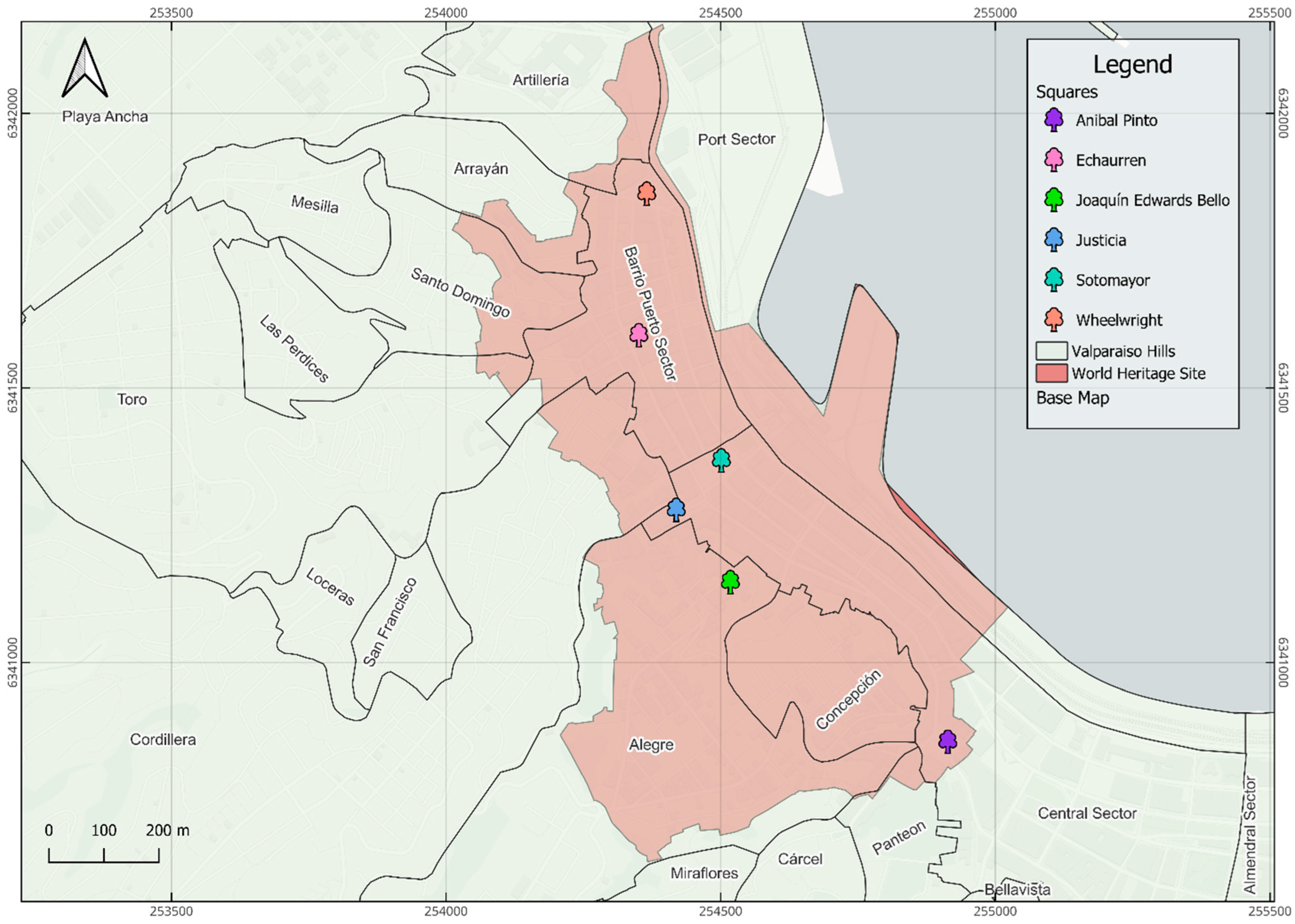
| Dimension | Description | Key Words |
|---|---|---|
| Density | Concentration of specific elements in each area, such as population, employment, housing, and commercial establishments. For Cervero et al. [40], it focuses mainly on the housing unit per hectare, the percentage of land area occupied by buildings, and the average height of the building floor. It is a measure that reflects how these entities are distributed and grouped in a geographic space, in this way administrative, residential, and commercial density are mentioned [49]. Density is crucial to understanding urban patterns and efficiently planning land use. | Concentration, Urban Patterns, Housing |
| Diversity | Diversity refers to the variety of land uses within an area, including the mix of different types of housing, retail, offices, and other services. This variety encourages proximity of different destinations, which can reduce the need for long vehicle trips and promote sustainable modes of transport such as walking and cycling [40]. Land use heterogeneity is a prominent indicator in urban planning, as it supports the needs of residents, ensuring a vibrant and welcoming community, and has a fundamental effect on travel patterns. A decrease in diversity leads to greater use of private cars to meet needs, while an increase in diversity favors the presence of pedestrians and cyclists [49]. Therefore, diversity increases the willingness to walk and cycle on streets and contributes to the perceived quality of the environment [50]. In addition, the entropy index is used to measure the diversity of land uses, quantifying the equitable distribution of different categories of land use and reflecting the degree of mixing and balance between these uses [40]. | Entropy Index, Land Use, Services, Multifunctionality, Heterogeneity |
| Design | The definition by Cervero et al. [40] clearly distinguishes between amenities, streets, and security. Amenities focus on green spaces and elements that beautify and enhance the landscape, such as the number of traffic lights, street vegetation, sky view, building façade, pedestrian space, motorization length, and diversity [50]. Street design focuses on the structure and connectivity of the urban fabric, including connectivity index, cycle path length, street density, shortest street distance, intersection density (per hectare), link node ratio, street length density [51], road network density, pedestrian network density, pedestrian network accessibility, entrances and exits at each station, floor area, and intersection ratio of road density [52], as well as street connectivity, accessibility, land use mix, street design level [49], and street connectivity (average block size) [53]. Safety addresses aspects related to the protection and well-being of pedestrians and drivers, considering the number of pedestrian accidents per year, average speeds of cars on main streets, deaths in traffic accidents and reported crimes, all per year [40]. | Security, Urban Structure, Planning, Functionality, Connectivity, Landscape |
| Destination | Movement potential at each street link from the centrality of the interrelation [50], as also understood from the density of bus stops, density of metro stations, network density [54], or the number of metro lines, metro frequency, metro station accessibility, number of bus stations, and number of parking [55]. From the stations, the attributes of capacity and number of nearby stations, cycling infrastructure and public transport facilities are observed [56], such as access to public transport (count-based index), trips within urban/suburban areas (boolean) [57]. It is also understood as the number of ca and walking trips made by a person in a single day; transport options in the neighborhood [58]. On the other hand, for Cervero et al. [40], it is understood from the amount of equipment, such as the number of public schools, hospitals, public bookstores, shopping centers, churches, banks, that is, towards service points. | Points of Interest, Shops, Accessibility, Transport Network, Facilities |
| Distance | Spatial measure between two points of interest. Cervero et al. [40] focuses on the transport network, such as shortest distances in the network to the nearest station and the exit of the metro station. Zhang et al. [50] focus on the nearest bus stop or approaches such as the distance to public centers in the city. It is also considered from points such as housing, work centers, services, and public transport [50]. Travel distance is understood as the distance to facilities [51]. In addition, distance is considered from the perspective of travel time, such as to the nearest educational establishments (primary, secondary, and higher education), travel time to the nearest urban center and travel time to the nearest public transport network, considering this as relative accessibility [53]. | Public Transport, Proximity to bus stops, travel time, efficiency, short distance. |
| Condition and use of social infrastructure | The condition and manner of use of social infrastructure, which includes public and private institutions serving the general population (e.g., libraries, schools, playgrounds, parks, sports fields, swimming pools, community organizations, scheduled markets, commercial establishments) and also elements of public space, such as sidewalks, courtyards, community gardens, and other spaces that invite people into the public realm [42]. Regarding the condition of social infrastructure, this refers to the state of maintenance of this infrastructure, while the manner of use refers to aspects of social behavior in places of social infrastructure, such as presence of trash on the streets, urban violence, ways in which users of means of transport behave in public space, carrying out of cultural activities in public space (e.g., music, art, meetings), and social norms (rules of behavior and ways of relating and treating people). | Social Behavior, Condition of Public Space, Perception of a Place |
| Dimension | Section 1 | Section 2 |
|---|---|---|
| Strength | What are the positive aspects of the transportation system and the current environment (social, urban and natural) of the Historic Heritage Center of Valparaíso from your mobility experience? | What characteristics does the Historic Heritage Centre of Valparaíso (transport system and surroundings) currently have that allow the use of electric bicycles (without making any changes to the city)? From your perception and/or experience in tourist and leisure routes. |
| Opportunity | What are the points to improve in the transportation system and the environment (social, urban and natural) of the Historic Heritage Center of Valparaíso based on your experience of mobility and frequent trips? | What characteristics could the Historic Heritage Centre of Valparaíso (transport system and surroundings) must allow for greater use of electric bicycles? From your perception and/or experience and for tourist and leisure routes. |
| Weakness | What are the negative points of the transportation system and the current environment (social, urban and natural) of the Historic Heritage Center of Valparaíso from your mobility experience? | What features does the Historic Heritage Centre of Valparaíso (transport system and surroundings) currently have that do not allow the use of electric bicycles (without making any changes to the city)? From your perception and/or experience in tourist and leisure routes. |
| Threat | What external factors could worsen or put at risk your mobility experience considering the transport system and the environment (social, urban and natural) of the Historic Heritage Centre of Valparaíso? From your perception and/or experience and tourist and leisure routes. | What external factors could worsen or jeopardize the development of electromobility? |
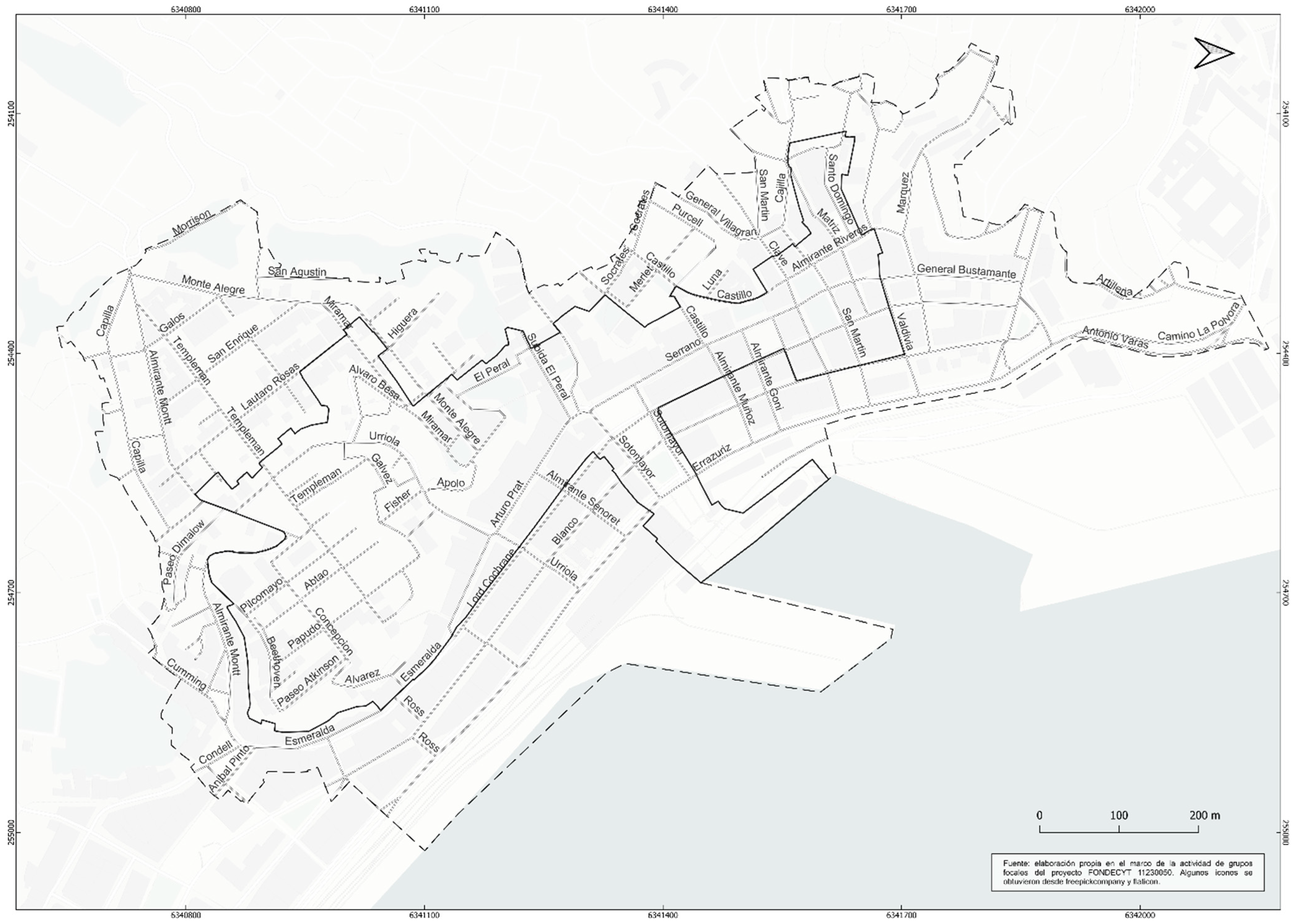
References
- Moslem, S.; Campisi, T.; Al-Rashid, M.A.; Simic, V.; Esztergár-Kiss, D.; Pilla, F. Greening Urban Mobility: Assessing Environmental and Functional Characteristics of Bicycle Infrastructure in the Post-Pandemic Era. Habitat Int. 2024, 153, 103200. [Google Scholar] [CrossRef]
- Ortar, N.; Lejoux, P.; Ovtracht, N. From Temporary Bike Lanes to a Cycling Oriented Mobility Paradigm. The Case of Lyon during and after the Pandemic of COVID-19. J. Urban Mobil. 2025, 7, 100103. [Google Scholar] [CrossRef]
- Sampieri, A. The Evolution of E-Bikes: Health and Environmental Advantages, Adoption Challenges, and the Emerging Technological Innovations. Ph.D. Thesis, Università Degli Studi Di Padova, Padova, Italy, 2025. [Google Scholar]
- Wisutwattanasak, P.; Watcharamaisakul, F.; Banyong, C.; Chantaratang, A.; Champahom, T.; Ratanavaraha, V.; Jomnonkwao, S. Promoting Electric Bicycle Sharing for Older Residents in Regional Areas: Multilevel Structural Equation Modeling Insights. Res. Transp. Bus. Manag. 2025, 61, 101399. [Google Scholar] [CrossRef]
- de la Paz, V. Valparaíso, Patrimonio de La Humanidad: Revisión de Algunos Indicadores Urbanos; Biblioteca del Congreso, Nacional de Chile: Santiago, Chile, 2023. [Google Scholar]
- ASCENVAL Usuarios de Ascensores de Valparaíso—Ascenval. Available online: https://www.ascenval.cl/ (accessed on 26 June 2024).
- UNESCO World Heritage Centre Barrio histórico de la Ciudad Portuaria de Valparaíso. Available online: https://whc.unesco.org/es/list/959 (accessed on 1 September 2023).
- Fernandes, V.A.; Tirado, H.M. Sustainable Mobility in Valparaíso, Chile, and Its Relationship with Topography and Socio-Spatial Conditions. J. Sustain. Sci. Manag. 2021, 16, 122–134. [Google Scholar] [CrossRef]
- Ministerio de Vivienda y Urbanismo. Vialidad Ciclo-Inclusiva; Serie Espacios Públicos Urbanos; Ministerio de Vivienda y Urbanismo: Santiago, Chile, 2015. [Google Scholar]
- SECTRA Encuestas de Movilidad. Available online: https://www.sectra.gob.cl/encuestas_movilidad/encuestas_movilidad.htm (accessed on 10 April 2023).
- Puchta, C.; Potter, J. Focus Group Practice; SAGE Publications Ltd.: London, UK, 2004; ISBN 978-0-7619-6691-3. [Google Scholar]
- Dilshad, R.M.; Latif, M.I. Focus Group Interview as a Tool for Quailitative Research: An Analysis. Pak. J. Soc. Sci. 2013, 33, 191–198. [Google Scholar]
- Hasanzadeh, K.; Ikeda, E.; Mavoa, S.; Smith, M. Children’s Physical Activity and Active Travel: A Cross-Sectional Study of Activity Spaces, Sociodemographic and Neighborhood Associations. Child. Geogr. 2023, 21, 287–305. [Google Scholar] [CrossRef]
- Delpino-Chamy, M.; Pérez Albert, Y. Assessment of Citizens’ Perception of the Built Environment throughout Digital Platforms: A Scoping Review. Urban Sci. 2022, 6, 46. [Google Scholar] [CrossRef]
- Kajosaari, A.; Haybatollahi, S.M.; Hasanzadeh, K.; Kyttä, M. Examining the Effects of Residential Location and Stated Residential Preferences on Activity Space Size and Centricity. Travel Behav. Soc. 2021, 23, 65–75. [Google Scholar] [CrossRef]
- Pánek, J.; Benediktsson, K. Emotional Mapping and Its Participatory Potential: Opinions about Cycling Conditions in Reykjavík, Iceland. Cities 2017, 61, 65–73. [Google Scholar] [CrossRef]
- Mindell, J.S.; Anciaes, P.R.; Dhanani, A.; Stockton, J.; Jones, P.; Haklay, M.; Groce, N.; Scholes, S.; Vaughan, L. Using Triangulation to Assess a Suite of Tools to Measure Community Severance. J. Transp. Geogr. 2017, 60, 119–129. [Google Scholar] [CrossRef]
- Pesola, A.J.; Hakala, P.; Berg, P.; Ramezani, S.; Villanueva, K.; Rinne, T. The Effects of Free-Fare Public Transportation on the Total Active Travel in Children: A Cross-Sectional Comparison between Two Finnish Towns. J. Transp. Health 2022, 27, 101506. [Google Scholar] [CrossRef]
- Mahmoudi, D.; Lubitow, A.; Christensen, M.A. Reproducing Spatial Inequality? The Sustainability Fix and Barriers to Urban Mobility in Portland, Oregon. Urban Geogr. 2020, 41, 801–822. [Google Scholar] [CrossRef]
- Molinero-Parejo, R.; Aguilera-Benavente, F.; Gómez-Delgado, M.; Soria-Lara, J.A. Mapping Disruptive Long-Term Scenarios Using a Participatory Approach. J. Maps 2021, 17, 106–115. [Google Scholar] [CrossRef]
- Vajjhala, S.P.; Walker, W.M. Roads to Participatory Planning: Integrating Cognitive Mapping and GIS for Transport Prioritization in Rural Lesotho. J. Maps 2010, 6, 488–504. [Google Scholar] [CrossRef]
- Hasanzadeh, K. Use of Participatory Mapping Approaches for Activity Space Studies: A Brief Overview of Pros and Cons. GeoJournal 2022, 87, 723–738. [Google Scholar] [CrossRef]
- UNESCO World Heritage Centre Lista del Patrimonio Mundial. Available online: https://whc.unesco.org/es/list/ (accessed on 15 April 2024).
- Consejo de Monumentos Nacionales Área Histórica de Valparaíso|Consejo de Monumentos Nacionales de Chile. Available online: https://www.monumentos.gob.cl/monumentos/zonas-tipicas/area-historica-de-valparaiso (accessed on 13 June 2025).
- IDE Patrimonio Polígonos Sitios de Patrimonio Mundial. Available online: https://idepat.patrimoniocultural.gob.cl/portal/sharing/rest/content/items/02ad13b6ea5d4421ad18ae73401844d3/data (accessed on 29 July 2025).
- Freepik Freepik|La Suite Creativa de IA Más Completa. Available online: https://www.freepik.es (accessed on 29 July 2025).
- Flaticon Flaticon, la Mayor Base de Datos de Iconos Gratuitos. Available online: https://www.flaticon.es/iconos (accessed on 29 July 2025).
- Servicio Nacional de Turismo Atractivos Turísticos Nacionales. Available online: https://www.geoportal.cl/geoportal/catalog/35088/Atractivos%20Tur%C3%ADsticos%20Nacionales (accessed on 29 July 2025).
- IDE Patrimonio Catálogo de Metadatos y Descarga de Capas del Patrimonio Cultural en Chile. Available online: https://ide.patrimoniocultural.gob.cl/es/centro_descargas (accessed on 9 January 2025).
- Consejo de Monumentos Nacionales de Chile Monumentos Nacionales|Consejo de Monumentos Nacionales de Chile. Available online: https://www.monumentos.gob.cl/monumentos (accessed on 29 July 2025).
- Instituto Nacional de Estadísticas Actividad del Turismo. Available online: https://regiones.ine.cl/valparaiso/estadisticas-regionales/economia/comercio-servicios-y-turismo/actividad-del-turismo (accessed on 29 July 2025).
- SERNATUR. Big Data Para el Turismo Interno; Servicio Nacional de Turismo|SERNATUR: Santiago, Chile, 2024. [Google Scholar]
- Instituto Nacional de Estadísticas Microdatos Censo 2017: Manzana. Available online: https://ine-chile.maps.arcgis.com/home/item.html?id=54e0c40680054efaabeb9d53b09e1e7a (accessed on 10 April 2023).
- Ibeas, A.; dell’Olio, L.; Montequín, R.B. Citizen Involvement in Promoting Sustainable Mobility. J. Transp. Geogr. 2011, 19, 475–487. [Google Scholar] [CrossRef]
- Zuev, D.; Tyfield, D.; Urry, J. Where Is the Politics? E-Bike Mobility in Urban China and Civilizational Government. Environ. Innov. Soc. Transit. 2019, 30, 19–32. [Google Scholar] [CrossRef]
- Kantawateera, K.; Naipinit, A.; Promsaka Na Sakolnakorn, T.; Churngchow, C.; Kroeksakul, P. A SWOT Analysis of Tourism Development in Khon Kaen, Thailand. Asian Soc. Sci. 2013, 9, 226. [Google Scholar] [CrossRef]
- Ares, P.; Risler, J. Manual de Mapeo Colectivo: Recursos Cartográficos Críticos Para Procesos Territoriales de Creación Colaborativa, 1st ed.; Tinta Limón: Buenos Aires, Argentina, 2013. [Google Scholar]
- Stewart, D.W.; Shamdasani, P.N. Focus Groups: Theory and Practice, 3rd ed.; Applied Social Research Methods Series; Sage: Los Angeles, LA, USA; London, UK; New Delhi, India; Singapore; Washington, DC, USA, 2015; ISBN 978-1-4522-7098-2. [Google Scholar]
- Saldaña, J. The Coding Manual for Qualitative Researchers, 3rd ed.; Sage: Los Angeles, LA, USA; London, UK; New Delhi, India; Singapore; Washington, DC, USA, 2016; ISBN 978-1-4739-0249-7. [Google Scholar]
- Cervero, R.; Sarmiento, O.L.; Jacoby, E.; Gomez, L.F.; Neiman, A. Influences of Built Environments on Walking and Cycling: Lessons from Bogotá. Int. J. Sustain. Transp. 2009, 3, 203–226. [Google Scholar] [CrossRef]
- Aprigliano, V.; Toro, C.; Rojas, G.; Barros, G.; Fukushi, M.; Seriani, S. Effects of the Built Environment and Sociodemographic Factors on Accessibility in the City of Valparaíso, Chile. J. Transp. Geogr. 2024, 118, 103931. [Google Scholar] [CrossRef]
- Latham, A.; Layton, J. Social Infrastructure and the Public Life of Cities: Studying Urban Sociality and Public Spaces. Geogr. Compass 2019, 13, e12444. [Google Scholar] [CrossRef]
- Morgan, D.L. Focus Groups. Annu. Rev. Sociol. 1996, 22, 129–152. [Google Scholar] [CrossRef]
- Bader, G.E.; Rossi, C.A. Focus Group: A Step-By-Step Guide; The Bader Group: San Diego, CA, USA, 2002. [Google Scholar]
- Foschiatti, A.M.; Alberto, J.A. El Uso de Matrices DAFO Como Herramientas de Gestión y Análisis Geográfico. Geográfica Digit. 2012, 9, 1–11. [Google Scholar] [CrossRef]
- Benzaghta, M.A.; Elwalda, A.; Mousa, M.; Erkan, I.; Rahman, M. SWOT Analysis Applications: An Integrative Literature Review. J. Glob. Bus. Insights 2021, 6, 55–73. [Google Scholar] [CrossRef]
- Ponce, H. La Matriz FODA: Alternativa de Diagnóstico y Determinación de Estrategias de Intervención En Diversas Organizaciones. Enseñ. Investig. Psicol. 2007, 12, 113–130. [Google Scholar]
- Namugenyi, C.; Nimmagadda, S.L.; Reiners, T. Design of a SWOT Analysis Model and Its Evaluation in Diverse Digital Business Ecosystem Contexts. Procedia Comput. Sci. 2019, 159, 1145–1154. [Google Scholar] [CrossRef]
- Motieyan, H.; Mesgari, M. Towards Sustainable Urban Planning Through Transit-Oriented Development (A Case Study: Tehran). ISPRS Int. J. Geo-Inf. 2017, 6, 402. [Google Scholar] [CrossRef]
- Zhang, L.; Ye, Y.; Zeng, W.; Chiaradia, A. A Systematic Measurement of Street Quality through Multi-Sourced Urban Data: A Human-Oriented Analysis. Int. J. Environ. Res. Public Health 2019, 16, 1782. [Google Scholar] [CrossRef]
- Masoumi, H. Home-Based Urban Commute and Non-Commute Trip Generation in Less-Studied Contexts: Evidence from Cairo, Istanbul, and Tehran. Case Stud. Transp. Policy 2022, 10, 130–144. [Google Scholar] [CrossRef]
- Qiang, D.; Zhang, L.; Huang, X. Quantitative Evaluation of TOD Performance Based on Multi-Source Data: A Case Study of Shanghai. Front. Public Health 2022, 10, 820694. [Google Scholar] [CrossRef]
- Lopes, M.; Mélice Dias, A.; Silva, C. The Impact of Urban Features in Cycling Potential—A Tale of Portuguese Cities. J. Transp. Geogr. 2021, 95, 103149. [Google Scholar] [CrossRef]
- Yang, W.; Chen, B.Y.; Cao, X.; Li, T.; Li, P. The Spatial Characteristics and Influencing Factors of Modal Accessibility Gaps: A Case Study for Guangzhou, China. J. Transp. Geogr. 2017, 60, 21–32. [Google Scholar] [CrossRef]
- Mahmoudi, J.; Zhang, L. Impact of County-Level Built Environment and Regional Accessibility on Walking: A Washington, DC–Baltimore Case Study. J. Urban Plann Dev. 2018, 144, 04018020. [Google Scholar] [CrossRef]
- Zhang, Y.; Thomas, T.; Brussel, M.; Van Maarseveen, M. Exploring the Impact of Built Environment Factors on the Use of Public Bikes at Bike Stations: Case Study in Zhongshan, China. J. Transp. Geogr. 2017, 58, 59–70. [Google Scholar] [CrossRef]
- Cheng, J.; Yan, R.; Gao, Y. Exploring Spatial Heterogeneity in Accessibility and Transit Mode Choice. Transp. Res. Part D Transp. Environ. 2020, 87, 102521. [Google Scholar] [CrossRef]
- Joh, K.; Boarnet, M.G.; Nguyen, M.T.; Fulton, W.; Siembab, W.; Weaver, S. Accessibility, Travel Behavior, and New Urbanism: Case Study of Mixed-Use Centers and Auto-Oriented Corridors in the South Bay Region of Los Angeles, California. Transp. Res. Rec. J. Transp. Res. Board 2008, 2082, 81–89. [Google Scholar] [CrossRef]
- Langchain AI. LangChain. GitHub. Available online: https://github.com/langchain-ai/langchain (accessed on 29 July 2025).
- Shao, Y.; Jiang, Y.; Kanell, T.A.; Xu, P.; Khattab, O.; Lam, M.S. Assisting in Writing Wikipedia-like Articles From Scratch with Large Language Models. arXiv 2024, arXiv:2402.14207. [Google Scholar] [CrossRef]
- Wang, L.; Ma, C.; Feng, X.; Zhang, Z.; Yang, H.; Zhang, J.; Chen, Z.; Tang, J.; Chen, X.; Lin, Y.; et al. A Survey on Large Language Model Based Autonomous Agents. Front. Comput. Sci. 2024, 18, 186345. [Google Scholar] [CrossRef]
- Hu, S.; Lu, C.; Clune, J. Automated Design of Agentic Systems. arXiv 2024, arXiv:2408.08435. [Google Scholar] [CrossRef]
- Banister, D. The Sustainable Mobility Paradigm. Transp. Policy 2008, 15, 73–80. [Google Scholar] [CrossRef]

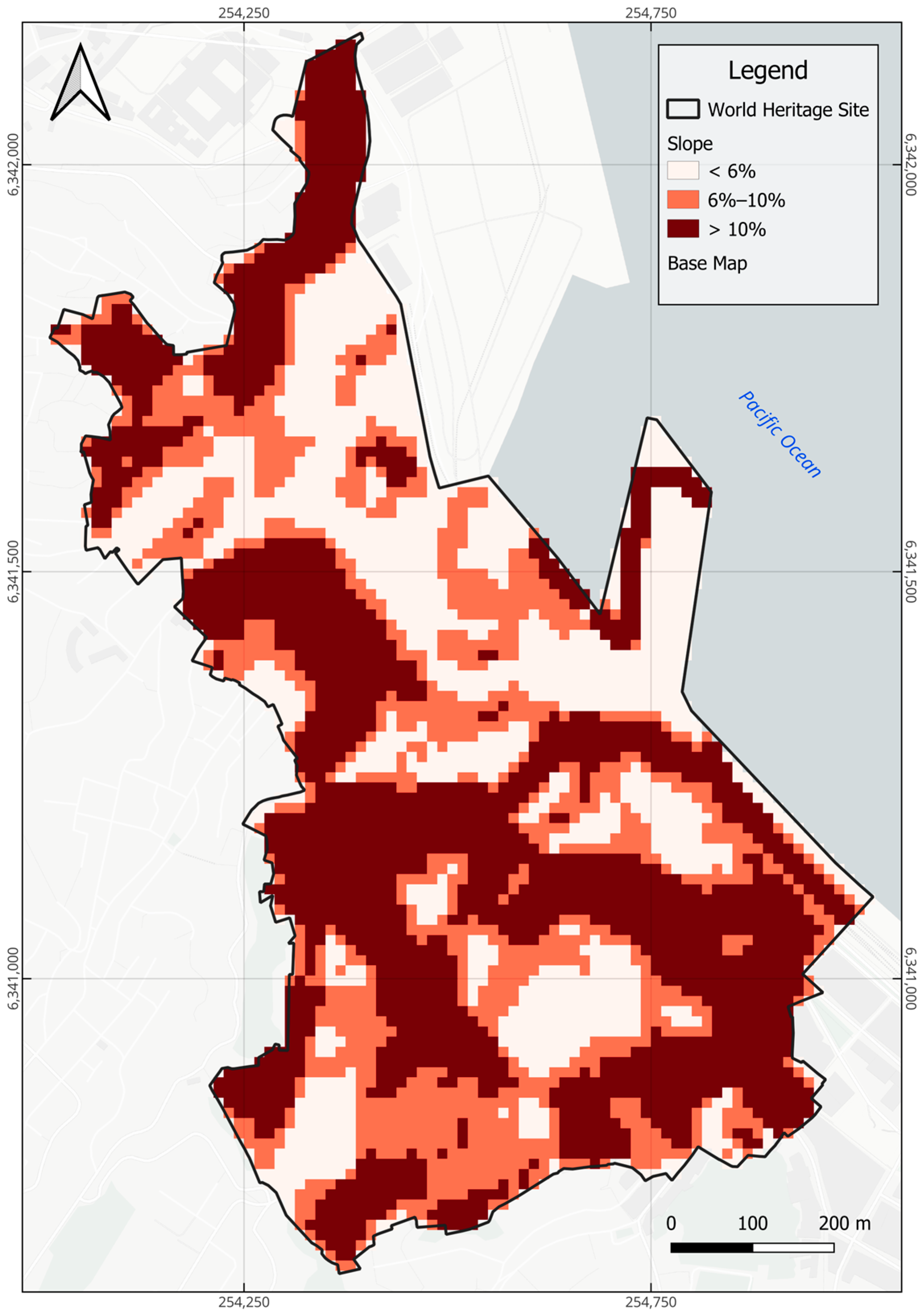
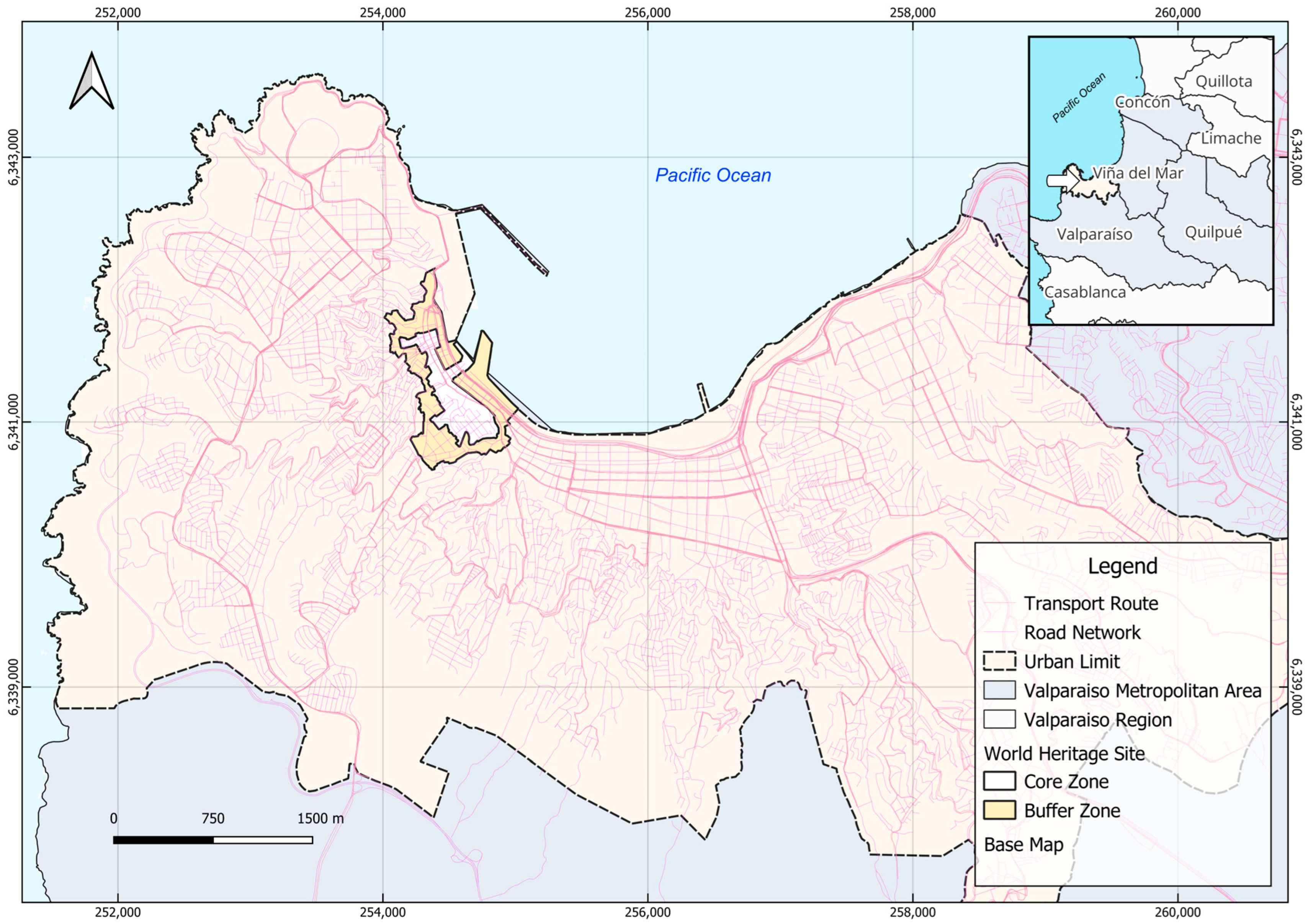
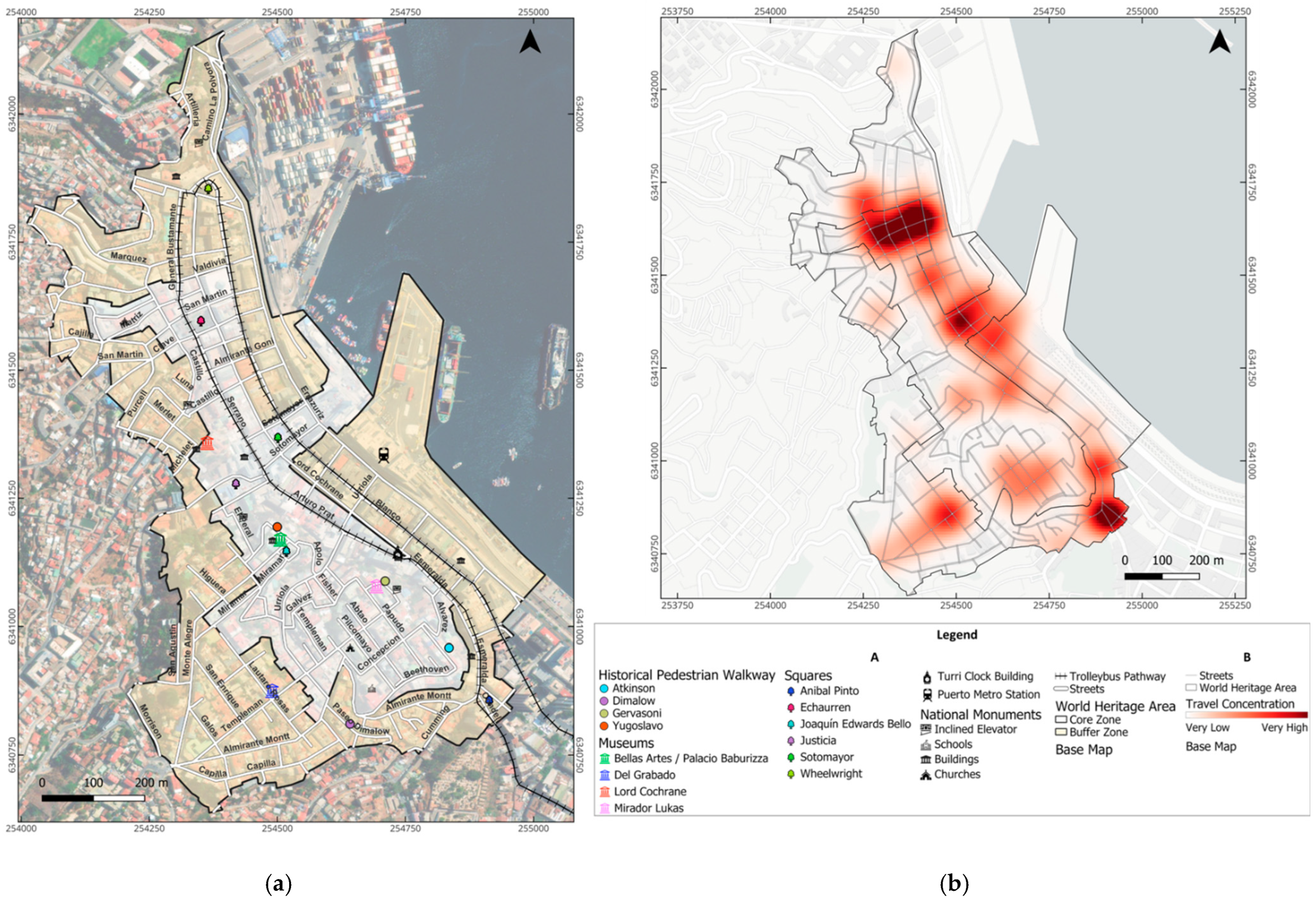

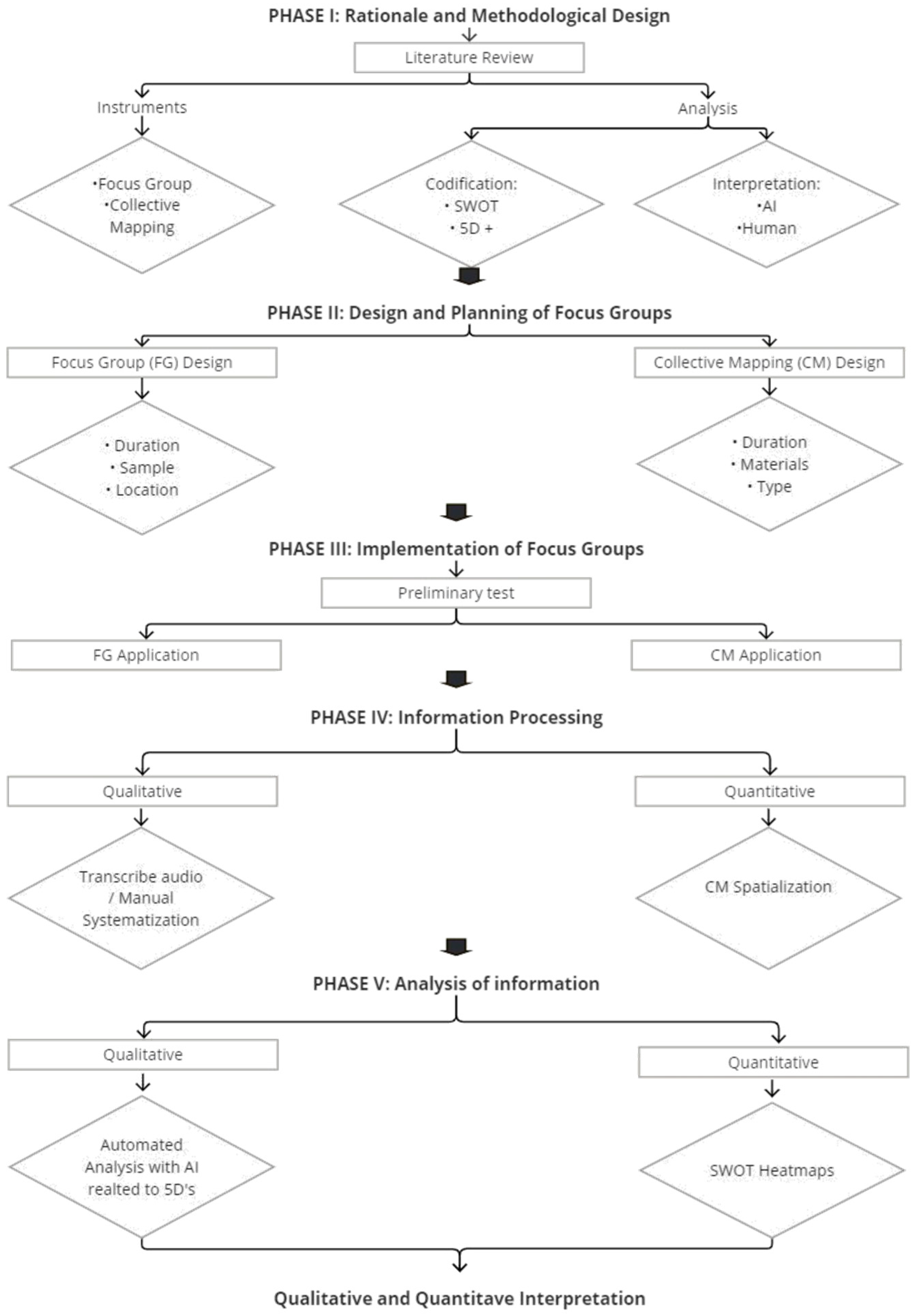
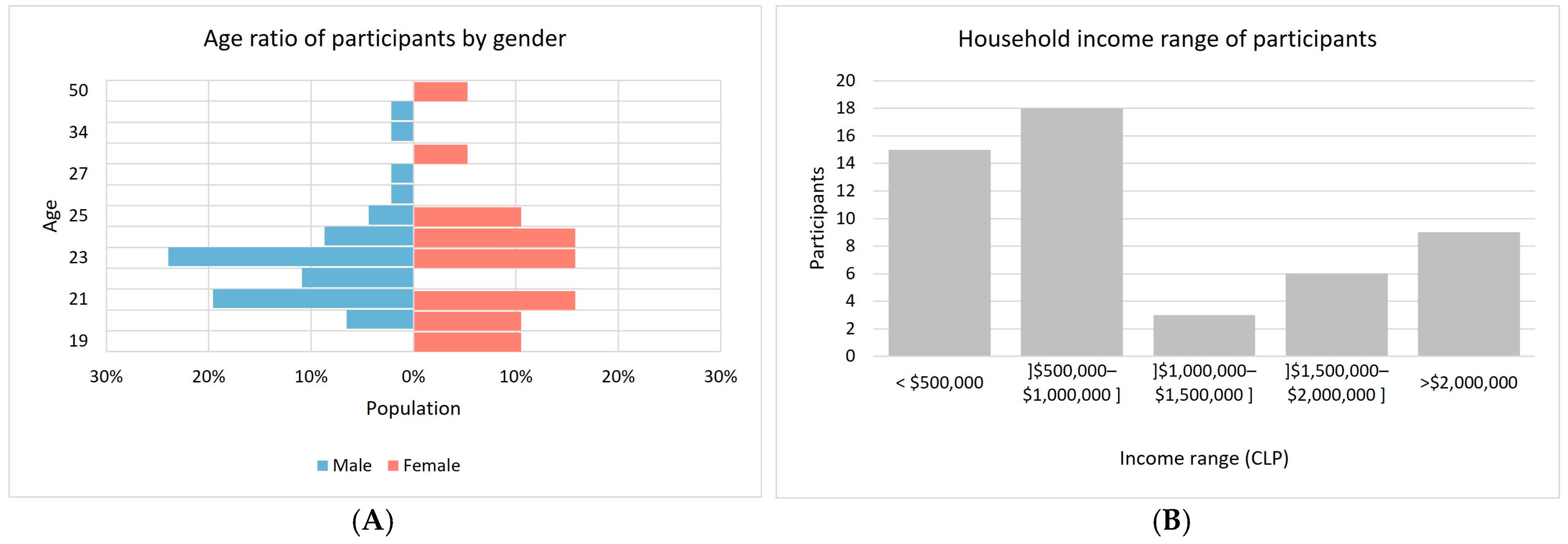


| Category | Original Name of the Place (in Spanish) | Designation Year | Source | ||
|---|---|---|---|---|---|
| National Monuments | 12 (54.5%) | Inclined Elevator | Artillería | 1998 | [30] |
| Concepción | |||||
| Cordillera | |||||
| El Peral | |||||
| Churches | Anglicana de San Pablo | 1979 | |||
| La Matriz del Salvador | 1971 | ||||
| Schools | Colegio Alemán | 2015 | [30] | ||
| Buildings | Castillo San José | 1963 | [30] | ||
| Edificio de calle Esmeralda N° 1118 | 1976 | ||||
| Edificio Luis Cousiño | 1981 | ||||
| Aduana de Valparaíso | 1976 | ||||
| Intendencia de Valparaíso | 1976 | ||||
| Typical or Picturesque Areas | 10 (45.5%) | Valparaíso Historic Area | Sector Pasaje Ross | 2003 | |
| Plaza Aníbal Pinto | |||||
| Cerros Alegre y Concepción | |||||
| Plaza Sotomayor | |||||
| Entorno de la Iglesia La Matriz | |||||
| Sector Quebrada Márquez | |||||
| Sector Plaza Echaurren y calle Serrano | |||||
| Sector del Cerro Cordillera’ y ‘Sector Bancario de Calle Prat |
| Destination Municipalities | Total Trips | % |
|---|---|---|
| Viña del Mar | 5,399,441 | 2.66 |
| El Tabo | 3,665,285 | 1.8 |
| La Serena | 3,413,834 | 1.68 |
| Algarrobo | 3,359,608 | 1.65 |
| El Quisco | 3,362,911 | 1.65 |
| Coquimbo | 3,341,642 | 1.64 |
| Valparaíso | 3,127,569 | 1.54 |
| Santiago | 3,127,315 | 1.54 |
| Pichilemu | 2,769,384 | 1.36 |
| Pucón | 2,712,155 | 1.33 |
| Indicators | Mean | Std | Min | 25% | 50% | 75% | Max |
|---|---|---|---|---|---|---|---|
| Ratio of women to total population | 0.47 | 0.14 | 0 | 0.46 | 0.50 | 0.54 | 0.76 |
| Average age | 41.86 | 4.39 | 37.06 | 38.08 | 41.57 | 43.55 | 50.51 |
| Household Size | 2.44 | 0.61 | 1.33 | 2.02 | 2.41 | 2.77 | 4.17 |
| Cars per household | 0.29 | 0.3 | 0 | 0.05 | 0.25 | 0.4 | 1 |
| Household income | 615,952.94 | 449,574.82 | 96,884 | 292,423 | 503,292 | 776,652.5 | 2,840,178 |
| Population in need of care | 1.26 | 0.76 | 0.02 | 0.35 | 1.43 | 1.79 | 2.81 |
| Primary education | 0.13 | 0.07 | 0.05 | 0.08 | 0.11 | 0.17 | 0.23 |
| Secondary education | 0.41 | 0.17 | 0.17 | 0.29 | 0.44 | 0.53 | 0.64 |
| Unemployed workforce | 0.15 | 0.06 | 0.06 | 0.11 | 0.14 | 0.17 | 0.26 |
| Workers | 0.5 | 0.16 | 0.19 | 0.45 | 0.49 | 0.59 | 0.75 |
| Immobility by illness | 0.04 | 0.03 | 0.01 | 0.02 | 0.04 | 0.05 | 0.24 |
| Car driving license | 0.32 | 0.18 | 0.16 | 0.21 | 0.27 | 0.33 | 0.72 |
| Households with bicycles | 0.33 | 0.18 | 0.02 | 0.18 | 0.3 | 0.43 | 1 |
| Indicators (Mean) | Leisure | Work | Others |
|---|---|---|---|
| Total Population | 4742 | 10,830 | 15,374 |
| Ratio of women total population | 1.24 | 0.41 | 1.02 |
| Average age | 40.39 | 42.74 | 36.44 |
| Household Size | 1.29 | 1.19 | 1.68 |
| Cars per household | 0.51 | 0.82 | 0.54 |
| Household income | 852,360 | 1,117,365 | 736,564 |
| Population in need of care | 0.28 | 0.1 | 0.27 |
| Primary education | 0.09 | 0.03 | 0.04 |
| Secondary education | 0.27 | 0.31 | 0.32 |
| Superior | 0.45 | 0.67 | 0.51 |
| Workers | 0.54 | 1.1 | 0.68 |
| Car driving license | 0.35 | 0.66 | 0.48 |
| Households with bicycles | 0.04 | 0.02 | 0.03 |
| Trips from Valparaíso | 14,079 | 11,931 | 26,033 |
| Trips from Greater Valparaíso | 16,832 | 21,572 | 33,019 |
| Strengths | Opportunities |
| Favorable internal elements or circumstances that help achieve objectives [45,46] | Favorable external circumstances originating in the environment that can lead to improvements or growth [45,47] |
| Weaknesses | Threats |
| Circumstances, skills, or negative and internal elements that harm the achievement of objectives [45] | Uncontrollable external negative factors or elements that impact the environment and hinder or delay the achievement of objectives [45,47,48] |
| Method | Coding | Description | Use |
|---|---|---|---|
| Exploratory | Holistic | It seeks generalities of the data, being useful for investigating different types of data, and considers a high amplitude in the sample size. | Variety of data types, crossing between Audio, Writing and geospatial information. |
| Provisional | List codes before collecting information, these can be modified during the course of the study. | Pre-coding: SWOT analysis Iconography 5D+ | |
| Grammatical | Attribute | Collect essential information from participants in terms of demographics. | Age, Gender, Academic Degree, Income |
| Magnitude | Statistical description for detailed analysis of demographic data. | Statistical measures | |
| Elemental | Structural | Compile topic lists or category indexes for already standardized or semi-structured data. | With the precoding of the SWOT Analysis, the structural coding seeks to identify those categories of relevance by SWOT dimension for the participants from the 5D+ codes. |
| Date | Focus Group Session | Total Focus Group | Total Participants | Female | Male | Average Age |
|---|---|---|---|---|---|---|
| 5 September 2023 | I | 4 | 19 | 4 (21.1%) | 15 (78.90%) | 23 |
| 6 November 2023 | II | 4 | 19 | 10 (52.6%) | 9 (47.4%) | 24 |
| 19 March 2024 | III | 4 | 28 | 5 (17.9%) | 23 (82.1%) | 22 |
| 11 May 2024 | IV | 1 | 4 | 2 (50%) | 2 (50%) | 34 |
| Areas of Improvement | Translated Paraphrasing |
|---|---|
| Infrastructure Enhancement | “Complementing what he (another participant) said, it would be like separating areas that are for vehicular traffic and for walking, like a separate cycle path, areas exclusively for cycle paths, and the other thing would be to designate key points because it is useless to make a route and still have to walk or go through sidewalks or streets in busy areas, for example creating a circuit that crosses as a key point, for example, the Puerto station, so that the cycle path is not too far from the Puerto station…” (male, date: 6 November 2023) “Good lighting, charging points, and better infrastructure…” (male, date: 19 March 2024) “…improve bus stops…” (male, date: 19 March 2024) “I think it is adapted, but with what is there, it is difficult to reach certain parts, so I think that improvement has to start from what is already created (referring to infrastructure), improve it in order to know what options there are to improve.” (Male, date: 19 March 2024) “From my experience, I believe that in terms of the historic center of Valparaíso, there is a focus on the hills more than anything else, in addition to what other participants said, I agree, I think that…the geography of Valparaíso is a limitation…the solutions that exist today, such as public transportation, elevators do not always respond to the demand that exists and the plan perhaps for Valparaíso not so much on the hills…it is not so limiting but yes the infrastructure, for example, the streets, the sidewalks due to their maintenance, make the hills less accessible” (Female, 11 May 2024) |
| Educational Campaigns | “I think that perhaps the electric bike does not necessarily require you to pedal, perhaps it is a plus on a slope, and obviously the issue of intimidation between the car and the bicycle and that the streets are very narrow, there should be good road signs, perhaps there should be campaigns like road safety education for drivers to do their part and not be so arrogant when driving with cyclists. That is what I think more than anything.” (female, date: 5 September 2023) “…encourage the use of bicycles in every sense and educate drivers, because drivers do not know how to coexist with cyclists here in Valparaíso” (male, date: 6 November 2023) |
| Route Optimization | “I believe that the most relevant factors are that there is a connection with other means of transportation…. such as the metro, for example, leaving bicycles outside…, connected to routes that are delimited and have security, and that the use of the bicycle is prioritized over the use of urban space for parking, for example, because of course there is a street that could be a two-way street but when one lane is occupied only by parking that in the end does not fulfill any function other than leaving a car there just like that and making an exclusive route for bicycles and leaving the route for pedestrians, they do not leave them (streets) integrated but rather they leave them separately segregated.” (male, 11 May 2024) |
| Community Engagement | “...for example, organizations that help, how do you see it? Because here too, here in Echaurren, there is a church here, so it is like the church’s soup kitchen, and that soup kitchen helps people on the street, they give them food, shelter, clothes, so it can be used in the same way.” (Female, 6 November 2023) “I believe that for me, one of the most relevant factors is that there is a political will so that governance can converse with infrastructure, and it is designed and planned to strengthen use (referring to the use of E-Bikes). So that means making decisions so that certain things happen, so in this case, designing tourist routes also has to do with that, that is, there is a will that we want it and not that a certain part of the community wants it but finally finds itself with bureaucracy and with a lack of interest or political apathy…” (Female, 11 May 2024) |
Disclaimer/Publisher’s Note: The statements, opinions and data contained in all publications are solely those of the individual author(s) and contributor(s) and not of MDPI and/or the editor(s). MDPI and/or the editor(s) disclaim responsibility for any injury to people or property resulting from any ideas, methods, instructions or products referred to in the content. |
© 2025 by the authors. Published by MDPI on behalf of the International Society for Photogrammetry and Remote Sensing. Licensee MDPI, Basel, Switzerland. This article is an open access article distributed under the terms and conditions of the Creative Commons Attribution (CC BY) license (https://creativecommons.org/licenses/by/4.0/).
Share and Cite
Aprigliano, V.; Toro, C.; Rojas, G.; Fukushi, M.; Bastías, I.; Seriani, S.; da Silva, W.R.; Peña, Á.; López-Quijada, L. The Potential Use of Electric Bicycles in the Historic Quarter of the Seaport City of Valparaíso, Chile, Through Participatory Mapping and Focus Groups Supported by AI Data Processing. ISPRS Int. J. Geo-Inf. 2025, 14, 405. https://doi.org/10.3390/ijgi14100405
Aprigliano V, Toro C, Rojas G, Fukushi M, Bastías I, Seriani S, da Silva WR, Peña Á, López-Quijada L. The Potential Use of Electric Bicycles in the Historic Quarter of the Seaport City of Valparaíso, Chile, Through Participatory Mapping and Focus Groups Supported by AI Data Processing. ISPRS International Journal of Geo-Information. 2025; 14(10):405. https://doi.org/10.3390/ijgi14100405
Chicago/Turabian StyleAprigliano, Vicente, Catalina Toro, Gonzalo Rojas, Mitsuyoshi Fukushi, Iván Bastías, Sebastián Seriani, William Ribeiro da Silva, Álvaro Peña, and Luis López-Quijada. 2025. "The Potential Use of Electric Bicycles in the Historic Quarter of the Seaport City of Valparaíso, Chile, Through Participatory Mapping and Focus Groups Supported by AI Data Processing" ISPRS International Journal of Geo-Information 14, no. 10: 405. https://doi.org/10.3390/ijgi14100405
APA StyleAprigliano, V., Toro, C., Rojas, G., Fukushi, M., Bastías, I., Seriani, S., da Silva, W. R., Peña, Á., & López-Quijada, L. (2025). The Potential Use of Electric Bicycles in the Historic Quarter of the Seaport City of Valparaíso, Chile, Through Participatory Mapping and Focus Groups Supported by AI Data Processing. ISPRS International Journal of Geo-Information, 14(10), 405. https://doi.org/10.3390/ijgi14100405






